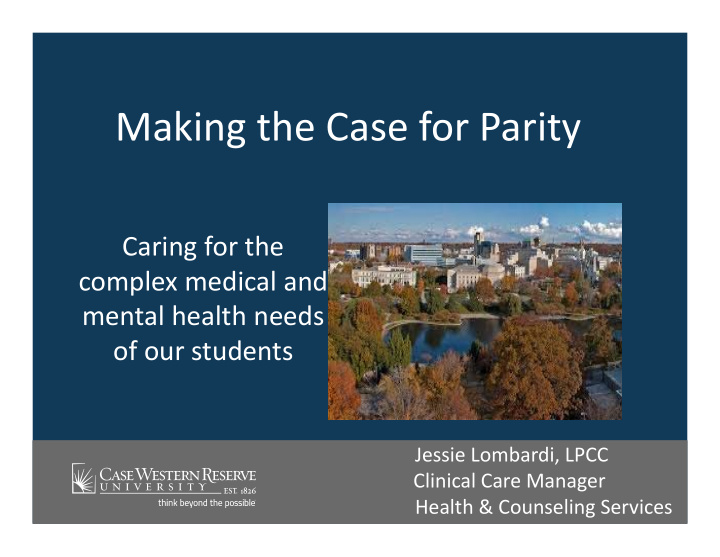



Making the Case for Parity Caring for the complex medical and mental health needs of our students Jessie Lombardi, LPCC Clinical Care Manager Health & Counseling Services
Who Is In The Room? • Does your institution have both a clinical and non clinical case/care manager? • Has your institution seen a recent increase in the following health concerns: • Head trauma/concussions • Injuries • Chronic medical problems • Life threatening medical problems • Increase in medical hospitalizations • Does your institution offer medical case/care management?
Care Management Parity: Agenda • Introduction to CWRU and our Clinical Care Management Model • Care Management Parity • Stake Holders and Buy ‐ In • Case Study • Questions & Discussion
Case Western Reserve University • Cleveland, OH – rich with medical and mental health services • University Hospitals – Case Medical Center • Cleveland Clinic • Case Western Reserve University : private, emphasis on STEM • 5,121 Undergraduate students: mostly residential • 6,219 Graduate and Professional Students • 14% of the population – international students • Cleveland Institute of Music: 400 students • Cleveland Institute of Art: 550 students • Urban campus
University Health & Counseling Services Integrated and Holistic view of student health and wellness • Mission Statement: To advance the well ‐ being, development, and academic success of our diverse student body through integrated medical, mental health, and wellness services. We collaborate with the entire CWRU community through outreach, education, and services to promote a culture of safety, respect, and global citizenship that fosters lifelong resilience. • Integration began July 2014 Not co ‐ located Major culture change! • Consultants hired
CWRU Care Management: timeline Summer 2015: Creation of Clinical Care Management position within Counseling Services • Discharge planning – behavioral health hospitalizations • Referral Coordination • UH&CS Tracking of “high risk” students • Other duties as assigned November 2015: Creation of The Care Management Process • Collaboration between UH&CS, Dean of Students Office, etc. • Care Plan and tracking • Only mental health concerns
CWRU Care Management: timeline Summer, 2016 • Quickly outgrew our resources and services September, 2016 Parity entered our vocabulary: Lawyer, integration consultants • • Care Management Specialist: Counseling Services, LSW & LPN Fall Semester 2016 & Spring Semester 2017 • Counseling Services = Supported by Care Management • Health Services = Poor follow ‐ up, tracking, referral coordination, and little to no campus collaboration Spring, 2017 • UH&CS Associate Director for Care Management Nurse Care Manager: Health Services •
Parity and the argument for Medical Case Management March 15 th , 2001: Senate Bill 543 the Mental Health Equitability Treatment Act of 2001 : Group health insurance must provide the same benefits for mental health services equal to those offered for medical and surgical services. Inversely the same needs to be true! Who are we missing by not offering collaborative, clinical case management services for medical health concerns? • Increases in: concussions, cancer, diabetes, crohn’s and other chronic medical conditions, transplant recipients, etc. • Mind body connection
CWRU Care Management Roles • Liaison for Counseling Services to Students of Concern meetings and document in EMR. • Nurse Care Manager: attend Students of Concern meetings and document in EMR • Referral coordination and follow up appointments/check ‐ ins • Nurse Care Manager: Referral coordination and follow up appointments/check ‐ ins • Advocate for the academic and student life needs of students with mental health concerns Provide medical documentation for academic and student life accommodations • Collaborating with the Dean of Students Office and other University Offices to create a Care • Plan. Monitor, track. • Collaborate with University Office to create a Care Plan. Monitor, track. • Discharge planning for mental health hospitalizations • Discharge planning for medical health hospitalizations • Continual evaluation of policies and procedures to • Support Psychiatry by providing check ‐ in appointments “No Wrong Door” • UH&CS Tracking of “high risk” students: Clinical Integration Leadership Team •
Stake Holders and Buy-In Within UH&CS Campus 1. Executive Director 1. Students 2. Director of Health 2. VP for Student Affairs 3. Director of Counseling 3. Dean of Students Office 4. Clinical Staff 4. Undergraduate Studies and Grad/Professional 5. Community Providers Studies 5. General Counsel
Case Study • 19 y/o, male, first year, Chinese International student • Came to Health Services for a “rash” that he couldn’t stop itching. Diagnosed with Eczema at Health Services. Previously unknown to UH&CS. • Did not follow up at Health Services, no ‐ showed his appointment • Students of Concern Meeting – faculty indicated concerns about student’s behavior in class. Leaving class abruptly and not returning. Missed an exam (Undergraduate Studies). • Dean of Students checked in with student – said he was doing ok, but was dealing with a “medical problem”. Didn’t request additional help. Referred to Health Services. • Students of Concern Meeting – Reports that he missed an entire week of classes (Undergraduate Studies). Was not responding to Undergraduate Studies or Dean of Students Office. • Students of Concern Meeting ‐ Res Life reports that father has been hanging around student’s residence hall and this was worrisome to other students. Reports from Police that father indicated student had been hospitalized for “eczema” and “itching”. • Behavioral Health hospitalization for anxiety and depression: student did not sign ROI Withdrew from CWRU and went home, with father, to China . •
Case Study Small Group Brainstorming Questions: 1. When could we have intervened for a potential different outcome? 2. How might your institution handle this situation/student? 3. Would Counseling Services help in this situation? Given the information known? 4. What would your Dean of Students Office done differently? 5. At your institution, when would this student be brought up to your “Students of Concern” meeting or “Care Team”? 6. What comes to mind when you read this case study?
Questions and Discussion Jessie Lombardi, LPCC JVL16@case.edu 216-368-5872
Recommend
More recommend